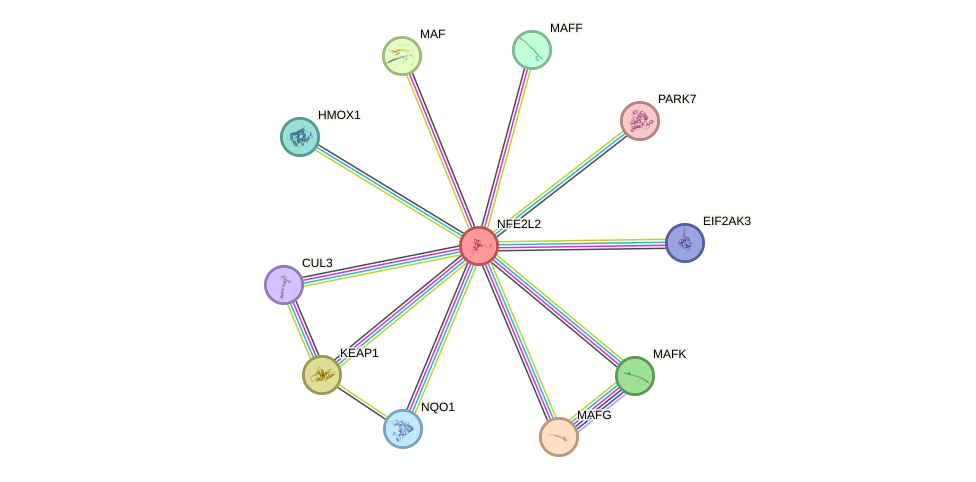GenAge entry for NFE2L2 (Homo sapiens)
Gene name (HAGRID: 283)
- HGNC symbol
- NFE2L2
- Aliases
- NRF2
- Common name
- nuclear factor, erythroid 2-like 2
Potential relevance to the human ageing process
- Main reason for selection
- Entry selected based on evidence directly linking the gene product to ageing in a cellular model system
- Description
Also known as NFE2L2, NF-E2-related factor 2 (NRF2) is a transcription factor that is activated by oxidative stress and electrophiles and has a role in inducing a number of antioxidative and carcinogen-detoxifying enzymes. Nrf2-deficient mice develop more tumors in response to carcinogens, and caloric restriction is ineffective in suppressing them in knockout mice. In contrast, caloric restriction remains effective in extending lifespan and increasing insulin sensitivity [2210]. In Nrf2-null mice fed a high-fat diet, the levels of hepatic triglycerides and cholesterol in liver were similar to wild type, while the levels of hepatic free fatty acid and malondialdehyde equivalents were higher, suggesting that Nrf2 inhibits lipid accumulation and oxidative stress in the mouse liver [2211].
In human fibroblasts, NRF2 shows a declined function in replicative senescence and its silencing leads to premature senescence. NRF2 activation results in the enhanced survival of cells following oxidative stress, whereas continuous treatment leads to lifespan extension of human fibroblasts [2212]. NRF2 has been also linked to several human age-related diseases, including atherosclerosis [2213], neurodegenerative diseases [2214], and cancer [2215]. It has been shown that progerin, an alternatively spliced product of LMNA involved in Hutchinson-Gilford progeria syndrome, sequesters NRF2, resulting in impaired NRF2 activity and increased oxidative stress. Suppressed NRF2 activity or increased oxidative stress is sufficient to recapitulate some of the accelerated aging effects seen in Hutchinson-Gilford progeria syndrome patients. Thus, NRF2 may play a role in accelerated human aging [4358].
Cytogenetic information
- Cytogenetic band
- 2q31
- Location
- 177,230,303 bp to 177,264,131 bp
- Orientation
- Minus strand
Protein information
- Gene Ontology
-
Process: GO:0006366; transcription from RNA polymerase II promoter
GO:0006954; inflammatory response
GO:0007568; aging
GO:0010499; proteasomal ubiquitin-independent protein catabolic process
GO:0010628; positive regulation of gene expression
GO:0010667; negative regulation of cardiac muscle cell apoptotic process
GO:0010976; positive regulation of neuron projection development
GO:0016567; protein ubiquitination
GO:0030194; positive regulation of blood coagulation
GO:0030968; endoplasmic reticulum unfolded protein response
GO:0034599; cellular response to oxidative stress
GO:0035690; cellular response to drug
GO:0036003; positive regulation of transcription from RNA polymerase II promoter in response to stress
GO:0036091; positive regulation of transcription from RNA polymerase II promoter in response to oxidative stress
GO:0036499; PERK-mediated unfolded protein response
GO:0042149; cellular response to glucose starvation
GO:0043161; proteasome-mediated ubiquitin-dependent protein catabolic process
GO:0043536; positive regulation of blood vessel endothelial cell migration
GO:0045454; cell redox homeostasis
GO:0045766; positive regulation of angiogenesis
GO:0045944; positive regulation of transcription from RNA polymerase II promoter
GO:0045995; regulation of embryonic development
GO:0046326; positive regulation of glucose import
GO:0070301; cellular response to hydrogen peroxide
GO:0071356; cellular response to tumor necrosis factor
GO:0071456; cellular response to hypoxia
GO:0071498; cellular response to fluid shear stress
GO:0071499; cellular response to laminar fluid shear stress
GO:1902037; negative regulation of hematopoietic stem cell differentiation
GO:1902176; negative regulation of oxidative stress-induced intrinsic apoptotic signaling pathway
GO:1903071; positive regulation of ER-associated ubiquitin-dependent protein catabolic process
GO:1903206; negative regulation of hydrogen peroxide-induced cell death
GO:1903788; positive regulation of glutathione biosynthetic process
GO:1904753; negative regulation of vascular associated smooth muscle cell migration
GO:2000121; regulation of removal of superoxide radicals
GO:2000352; negative regulation of endothelial cell apoptotic process
GO:2000379; positive regulation of reactive oxygen species metabolic process
Cellular component: GO:0000785; chromatin
GO:0005634; nucleus
GO:0005737; cytoplasm
GO:0005813; centrosome
GO:0005829; cytosol
GO:0005886; plasma membrane
GO:0032993; protein-DNA complex
Hide GO termsFunction: GO:0000976; transcription regulatory region sequence-specific DNA binding
GO:0000980; RNA polymerase II distal enhancer sequence-specific DNA binding
GO:0001102; RNA polymerase II activating transcription factor binding
GO:0001205; transcriptional activator activity, RNA polymerase II distal enhancer sequence-specific binding
GO:0001221; transcription cofactor binding
GO:0003677; DNA binding
GO:0003700; transcription factor activity, sequence-specific DNA binding
GO:0005515; protein binding
GO:0019904; protein domain specific binding
GO:0044212; transcription regulatory region DNA binding
Protein interactions and network
- Protein-protein interacting partners in GenAge
- HDAC3, AKT1, MYC, NCOR1, PRKCD, BRCA1, CREBBP, GSK3B, PRKCA, HDAC1, MAPK8, JUN, MAPK9, HDAC2, SUMO1, NCOR2, CDKN1A, SQSTM1
- STRING interaction network
Retrieve sequences for NFE2L2
Homologs in model organisms
In other databases
Selected references
External links
- EPD
- ORF Accession
- NM_001145413
- CDS Accession
- NP_001138885
- OMIM
- 600492
- HPRD
- 02732
- Ensembl
- NFE2L2
- UniProt/Swiss-Prot
- NF2L2_HUMAN
- GeneCards
- NFE2L2
- Entrez Gene
- 4780
- UniGene
- 731566
- GenAtlas
- NFE2L2
- Internet
- Search Google

